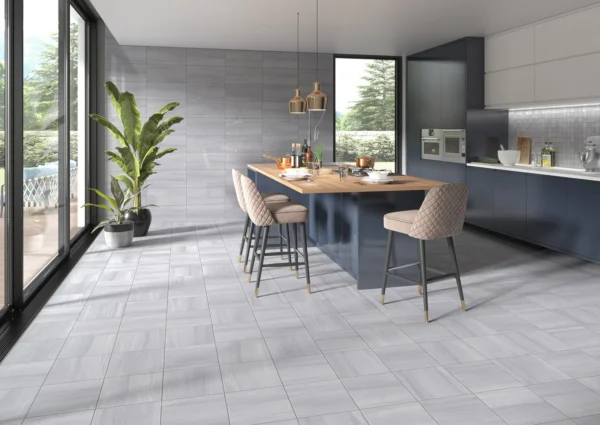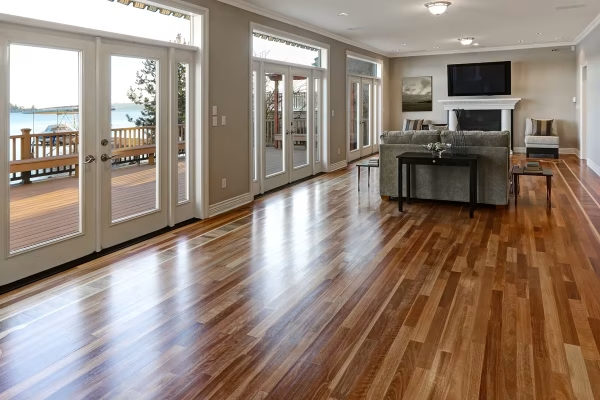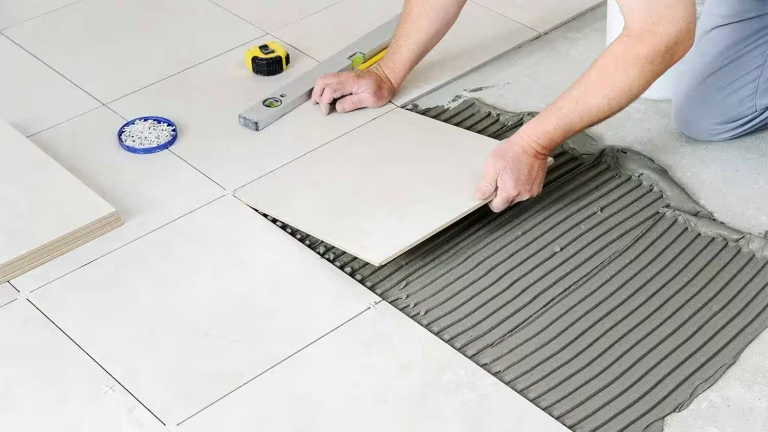
Everything You’ll Need
Tool Checklist: Ceramic vs. Porcelain Tile
| Tool / Material | Ceramic Tile | Porcelain Tile | Purpose |
|---|---|---|---|
| Tape Measure | ✔ | ✔ | Measure room size and tile gaps |
| Chalk Line | ✔ | ✔ | Mark center lines and guides |
| Straight Edge | ✔ | ✔ | Guide straight cuts and lines |
| Pry Bar | ✔ | ✔ | Take out baseboards or old floors |
| Spacers | ✔ | ✔ | Keep grout spaces even |
| Notched Trowel | ✔ | ✔ | Spread mortar evenly |
| Mixing Paddle & Drill | ✔ | ✔ | Mix mortar and grout right |
| Wet Saw or Tile Cutter | ✔ | ✔ | Cut tiles for edges and corners |
| Utility Knife | ✔ | ✔ | Trim underlayment or score board |
| Level | ✔ | ✔ | Make sure tiles are even |
| Grout Float | ✔ | ✔ | Press grout into joints |
| Bucket & Sponge | ✔ | ✔ | Clean tiles and wipe grout |
| Knee Pads | ✔ | ✔ | Protect knees when kneeling |
| Safety Glasses | ✔ | ✔ | Protect eyes during cuts |
| Gloves | ✔ | ✔ | Protect hands from sharp edges |
| Cement Backer Board (if needed) | ✔ | ✔ | Stabilize tiles and resist moisture |
Optional (But Helpful):
| Tool / Material | Purpose |
|---|---|
| Rubber Mallet | Gently tap tiles into place |
| Tile Nippers | For small and precise cuts |
| Grout Sealer | Seal grout to protect from moisture |
Step 1: Prepare the Space
Take Off Baseboards and Old Floors
Begin by taking off any baseboards and old floors to show the subfloor. This gives a clean, flat surface for your tile work.
Use a pry bar to gently remove the baseboards without hurting the walls. If you’re replacing laminate or vinyl, cut them into small pieces and remove all glue. For old tile, use a hammer and chisel or a floor scraper to take out the tiles and mortar.
Clean the Subfloor Well
Sweep and vacuum the subfloor to remove all dust, dirt, and trash. A clean surface helps the mortar stick well and keeps your floor smooth.
Check for Damage or Moisture
Look at the subfloor for cracks, holes, or bumpy spots. Use a level to find dips or high areas.
- Cracks or holes: Fill them with a patching mix.
- Uneven areas: Use a floor leveling mix to make a flat, steady base.
If working over concrete, check for moisture with a moisture meter. Too much moisture can cause tile or grout problems, so fix any moisture issues first.
Put in Underlayment or Cement Backer Board (if needed)
Based on your subfloor type:
- Wood subfloors: Put in cement backer board for a strong, water-safe base.
- Concrete subfloors: Usually don’t need underlayment, but a crack isolation membrane or waterproofing membrane might be suggested sometimes.
Secure backer board panels following manufacturer instructions, using the right screws and leaving gaps between panels.
Step 2: Plan Your Tile Layout
Find Room Center and Mark Lines
Start by finding the center of the room. Measure to get the middle of each wall and draw chalk lines across the floor. Where these lines meet is where you start laying tiles. This makes sure your tiles look even and balanced.
Pick Your Tile Pattern
If you’re new to this, use easy patterns:
- Straight Lay (Grid Pattern): Tiles are lined up square with the walls, making neat rows.
- Diagonal (Diamond Pattern): Tiles are set at a 45-degree angle to the walls for a lively look — a bit harder but doable.
Note: Complicated designs like herringbone or chevron need more skill and are not good for beginners.
Test Tile Fit
Lay a few rows of tiles without mortar (this is called dry-fitting). This lets you:
- Check how they line up and the spacing.
- See how tiles meet walls, cabinets, or doors.
- Adjust to avoid thin tile pieces at edges (which might look odd and crack).
Grout Line Spacing
Put spacers between tiles during the dry fit for even grout lines. Typical spacer sizes are 1/8 inch or 3/16 inch, based on tile size and style.
Figure Out Tile Amount (Add 10–15% for Waste)
Measure the room’s area (length × width). Then:
- Multiply the total area by 1.10 (for simple layouts) or 1.15 (for diagonal or rooms with many cuts) to allow for cuts, mistakes, and future fixes.
- Order that much tile to have enough for the whole job.
Step 3: Choose Your Installation Method
For most tile flooring jobs, especially big ones, thinset mortar is the best way to install tiles. It creates a strong, lasting link between tiles and the floor beneath.
Common Methods:
- Thinset Mortar (Recommended)
This cement-based glue is perfect for floor tiles. It handles weight, moisture, and temperature changes well. Most DIYers and pros use thinset because it is durable and reliable. - Tile Adhesive (Mastic)
Good only for small DIY areas or wall tiles in dry spots. It’s easier to use but not strong enough for most floors or wet places.
Note: If you’re tiling a floor, thinset is almost always the best and safest choice.
| Installation Method | Best For | Strength & Durability | DIY Friendliness | Notes |
|---|---|---|---|---|
| Thinset Mortar | Floor tiles, wet areas (bathrooms, kitchens), large spaces | ⭐⭐⭐⭐⭐ (Excellent) | Moderate | Industry standard for tile flooring. Handles moisture, weight, and movement. |
| Tile Adhesive (Mastic) | Small dry areas, wall tiles | ⭐⭐ (Limited) | Easy | Not recommended for floor tiles or high-moisture areas. Faster application but lower durability. |
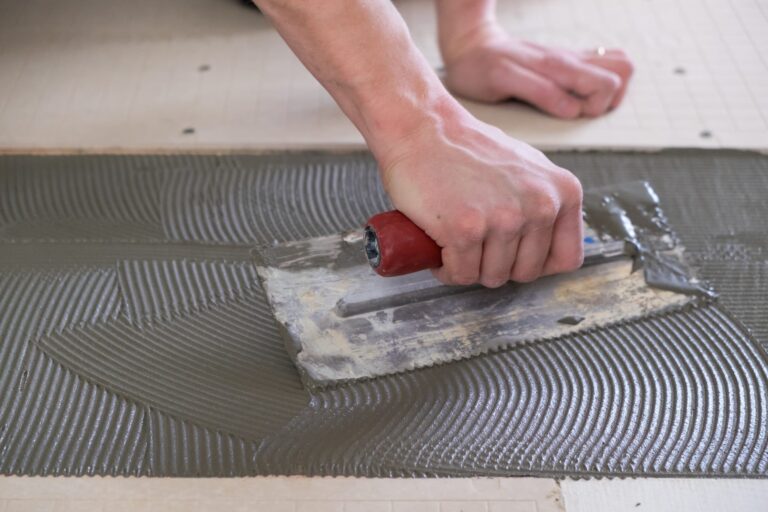
Step 4: Mix Mortar and Apply to Subfloor
Mix the Mortar
First, mix the thinset mortar as the maker says. Use a clean bucket and a mixing paddle with a drill to make it smooth with no lumps. Let it sit for a few minutes, then mix again before use.
Spread the Mortar
Use a notched trowel to spread the mortar evenly on a small part of the subfloor. Keep the trowel at a 45-degree angle to make even ridges. These ridges help the tile stick well and ensure the right depth for a level floor.
Work in Small Sections
Only cover the area you can tile in about 10–15 minutes. This keeps the mortar from drying before you set the tiles.
Pro Tip:
Put a thin layer of mortar on the back of bigger tiles for better sticking, especially for tiles over 12 inches.
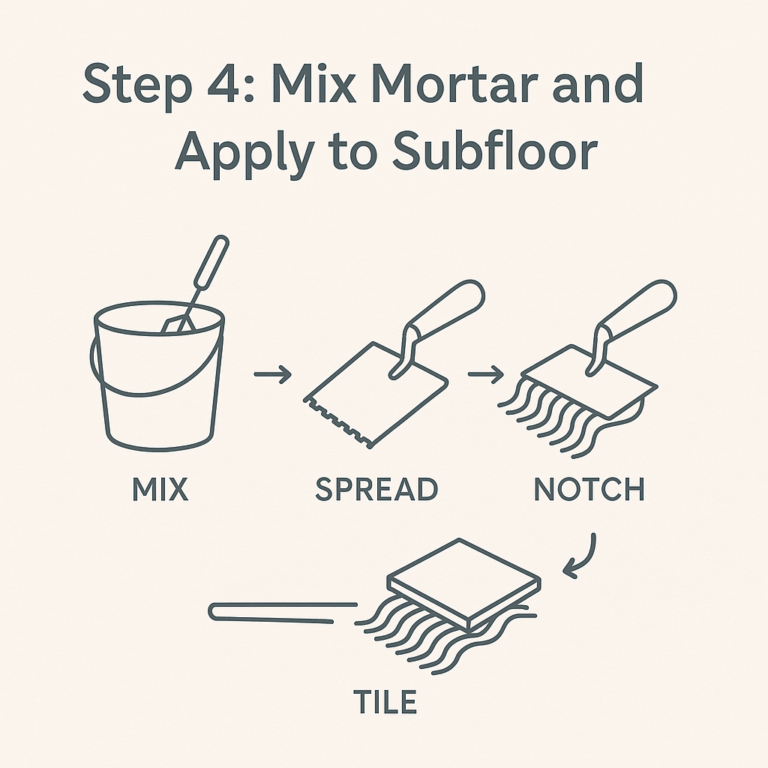
Step 5: Lay the First Tiles
Starting right is important for the whole project.
Begin at Your Layout Center Point
Use chalk lines from your planning to start at the room’s center or a key point. This makes sure tiles are spread out evenly.
Set the First Tile
Put the first tile into the mortar. Press down firmly and turn it a bit to make it stick well.
Use Tile Spacers
Place spacers between each tile to keep even gaps for grout. This gives a neat, professional look.
Check for Level
After a few tiles, use a level to make sure the surface is flat. Make changes if needed before the mortar hardens.
Pro Tip:
Work in small areas so the mortar stays wet until the tiles are placed!
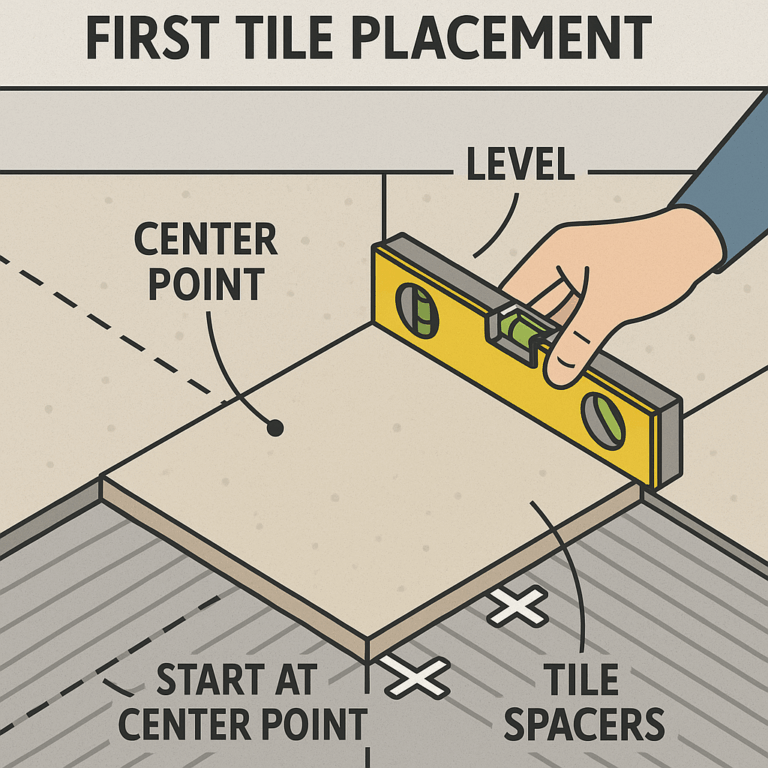
Step 6: Cutting Tiles to Fit
Cutting tiles right is important for a neat look.
Measure and Mark
Use a tape measure to find the size of the tile you need. Mark the cut line clearly with a pencil.
Choose the Right Tool
Use a manual tile cutter for straight cuts.
For curved or intricate cuts, use a wet saw or an angle grinder with a diamond blade.
Cut in a Safe Area
Always cut outside or in a place with good air to avoid dust. Wear safety glasses and gloves for safety.
Pro Tip:
Measure twice before cutting to save material and fit well!
Step 7: Install Remaining Tiles and Let Mortar Cure
Start placing the first tiles, then keep adding more tiles one row at a time. Begin from your starting point and use spacers for even grout lines. Make sure tiles are level and adjust if needed to avoid bumps.
Don’t step on new tiles to stop them from moving. Work in small areas so the mortar stays wet until tiles are set.
When all tiles are in place, let the mortar cure for at least 24 hours (or follow the maker’s advice) before grouting. Proper curing is key for a strong and lasting tile floor.
Step 8: Apply Grout
Once the mortar is set, it’s time to grout the spaces between the tiles:
Mix the Grout
Read the instructions to mix the grout until it’s smooth like peanut butter.Spread Grout Using a Float
Hold a rubber grout float at an angle and spread grout over the tiles. Press to fill all the spaces.Remove Excess Grout
After filling, angle the float steeply and scrape off extra grout from the tiles.Clean the Tiles with a Damp Sponge
Wait 10 to 15 minutes, then gently wipe tiles with a damp sponge. Rinse often and keep grout in the spaces.Final Buffing
After 30–60 minutes, when grout hazes, use a dry microfiber cloth to buff and clear haze.
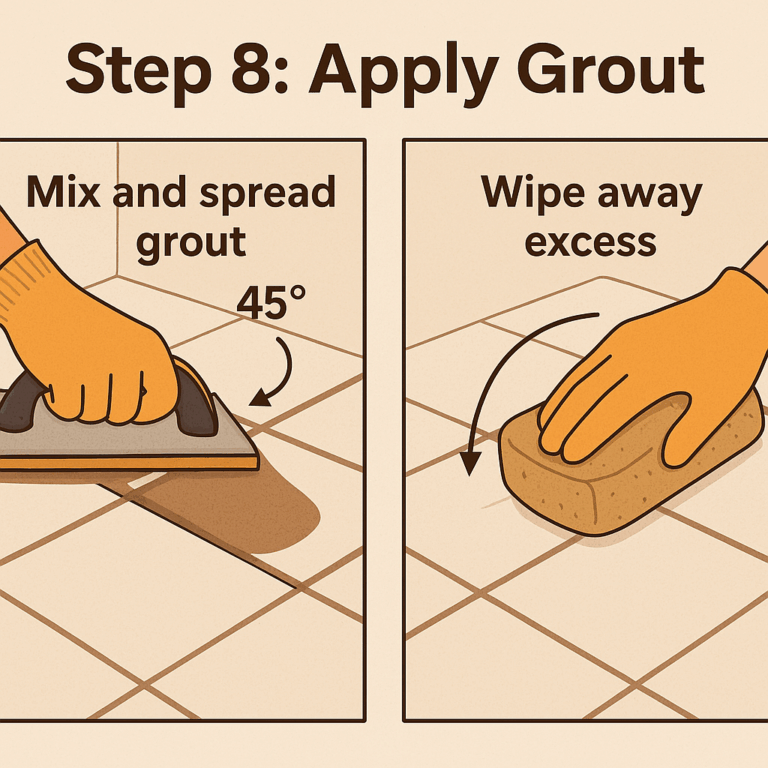
Step 9: Clean and Seal the Floor
Remove Grout Haze
Once the grout dries (usually 24 to 48 hours), a cloudy layer may form on the tiles. Use a damp sponge or a special grout haze remover to clean the tiles gently. Be careful not to touch the grout lines.
Apply Grout Sealer
If the grout maker suggests it, put on a grout sealer to keep out moisture, stains, and mold. Use a small brush or a sealer bottle with a roller tip to apply it carefully. Let the sealer dry completely according to the instructions.
Reinstall Baseboards and Transition Strips
Once everything is clean and dry, put back your baseboards and add transition strips if needed between different floor types or rooms. This makes your new tile floor look neat and professional.
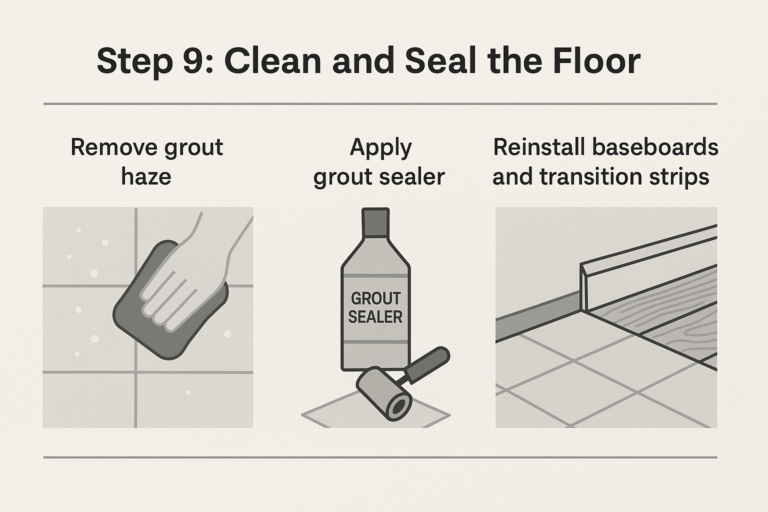
DIY vs. Professional Tile Installation
Installing tile floors by yourself can save money, but it’s not always the best for every project. Here’s how to choose between DIY and hiring a pro.
DIY Pros
- Costs less upfront
- Work at your own speed
- Good for small, simple rooms (bathrooms, laundry rooms)
DIY Cons
- Takes time and special tools
- Mistakes can be expensive to fix
- Hard for big or tricky spaces
Professional Installation Pros
- Expert work and lasting results
- Faster finish, great for big areas
- Handles subfloor prep, cutting, and cleaning
- Often comes with warranties
Professional Installation Cons
- Costs more upfront
- Less control over timing
Cost Comparison
Here’s what you can expect to pay:
| Installation Type | Average Cost per Sq Ft | Typical Total for 250 Sq Ft |
|---|---|---|
| DIY Installation | $2 – $8 (materials + rental tools) | $500 – $2,000 |
| Professional Installation | $8 – $25 | $2,000 – $6,250 |
👉 For a full breakdown, check out our Tile Flooring Cost Guide.
Pro Tips for a Successful Tile Flooring Installation
Want pro results for your DIY tile project? Keep these tips in mind:
- Organize tools and tiles before you start. Keep them within easy reach.
- Use a good wet saw for neat cuts, especially with porcelain tiles.
- Mix small amounts of mortar and grout. This stops them from drying out too soon.
- Check for level often with a spirit level as you lay tiles.
- Work in small areas. This keeps the mortar from drying before placing tiles.
- Reduce breakage. Cut tiles slowly and wear safety glasses.
Common Mistakes to Avoid When Installing Tile Flooring
Even skilled DIYers can make these mistakes:
- Skipping subfloor leveling. Uneven subfloors can cause cracked tiles and crooked lines.
- Forgetting spacers. Uneven grout lines look unprofessional.
- Walking on tiles before the mortar cures. This can shift tiles and ruin alignment.
- Using too much or too little mortar. This can lead to poor adhesion or uneven tiles.
- Not cleaning grout haze quickly. If left too long, grout haze is hard to remove.
Do You Need Professional Help With Your Tile Flooring Installation Project?
You’ve learned how to install tile flooring step-by-step, so you can create a strong, beautiful surface that lasts a long time. But if you want experts to do the work — like leveling, cutting, and grouting — we can help.
Our expert flooring installation team manages every detail — from preparing the subfloor to laying and sealing each tile. This ensures a perfect, long-lasting finish. We’ll help you choose the best tile style and materials for your space and budget.
Contact us today to schedule your free in-home consultation and see if we serve your area!

